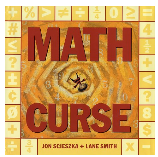Let me introduce a new method entitled "Just Cross".
First and foremost, you must understand what division is. The statement 8 ÷ 4 means 8 divided into 4 equal sets, OR how many fours are in eight, OR how many times can we subtract 4 from 8? (Yes, division is repeated subtraction.)
Let me explain this using a hands-on visual. Let’s assume the fraction problem is:
First and foremost, you must understand what division is. The statement 8 ÷ 4 means 8 divided into 4 equal sets, OR how many fours are in eight, OR how many times can we subtract 4 from 8? (Yes, division is repeated subtraction.)
Let me explain this using a hands-on visual. Let’s assume the fraction problem is:
The question being asked is, “How many ¼’s are in ½?”
 First, fold a piece of paper in half. The figure on the left represents ½. Next, fold the same sheet of paper in half again to make fourths as seen in the illustration on the right. When you unfold the paper, you will notice a total of four sections. So answering the original question: “How many ¼’s are in ½”, you can see that the half sheet of paper contains two parts; therefore:
First, fold a piece of paper in half. The figure on the left represents ½. Next, fold the same sheet of paper in half again to make fourths as seen in the illustration on the right. When you unfold the paper, you will notice a total of four sections. So answering the original question: “How many ¼’s are in ½”, you can see that the half sheet of paper contains two parts; therefore:Using the same example, to work the problem, the fraction 1/4 would have to be flipped to 4/1 nd then 1/2 would have to multiplied by 4/1 to get the correct answer of 2. That is why the division of fractions requires that the second fraction be inverted and the division sign be changed to a multiplication sign.
- Cross your arms as a hands-on way of remembering the process.
- Now multiply the denominator of 4 by 1 the denominator of 2 by1 as seen below. (We do nothing with the denominators.) Notice we always start on the right side and then we go to the left side. If it is done the opposite way, the answer will be incorrect. The answer of our first "cross" is the numerator (4 x 1); the answer to our second "cross" (2x1) is the denominator.
- Now simply divide 4 by 2 to get the answer of 2.
-------------------------------------------------------------------------------
 |
| $4.75 |
Although fractions are something every student should learn, often times numerous students are left behind in the mathematical dust when a math textbook is followed page by page. I have a resource that features different ways to teach fractions using hands-on strategies similar to the one above. The unconventional techniques described in this math resource will always work. Just go to Unlocking Fractions for the Confused and Bewildered.








